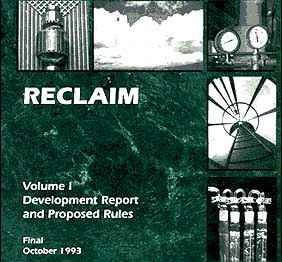Iron and Steel Overview: Regulations and NOx Control
|
Courtesy of the South Coast Air Quality Management District. |
Canadian Iron and Steel Industry
Employment and Productivity
Energy Consumption
Environmental Issues
Industry Modernization and Restructuring
Integrated Mill Business Structure
International Competition
Labor Issues
Market Drivers
Price Trends
Products and Markets
Regulations and NOx Control
Rolling Mills / Secondary Finishing
Sales Revenue and Profitability
Shipments by Major Markets
Shipments by Type of Market
Shipments by Type of Product
U.S. Share of World Output
U.S. Steel Shipments
The iron and steel industry is subject to a wide array of air, water, and land-use pollution regulations.
Clean Air Act Amendments of 1990
Over 160 steel industry facilities are classified as major sources of air pollution generating 220 million lbs./year of the six criteria (Nitrogen oxides, sulfur oxides, particulate matter, volatile organic compounds, carbon monoxide, and lead) pollutants that are controlled under Title I of CAAA 1990. Many of these facilities are located in national ambient air quality standards (NAAQS) nonattainment regions and are or will be subject to tighter requirements on emissions for both existing major sources and for new or expanded sources. State Implementation Plans (SIPs) are being written that may require more stringent control of criteria pollutants. The steel industry must also comply with Title III of the Act dealing with Hazardous Air Pollutants. Coke production and chemicals recovery are particularly affected by Title III regulations. The act also provides for more stringent permitting and measurement procedures placing the burden of proof on the mills themselves.
SCAQMD Regional Clean Air Incentives Market
The South Coast Air Quality Management District has a unique air quality program that applies to facilities emitting 4 tons or more of NOx per year. The RECLAIM program ([South Coast] Regional Clean Air Incentives Market) has set year by year declining emissions ceilings for facilities. Credits are issued for these emissions levels. Facilities can invest in emissions reduction technology, adjust facility operation schedules, or buy credits to achieve the necessary pollution reductions. A facility that can economically achieve a greater reduction in pollutant emissions, can sell it’s credits to other emitters. This market is designed to ensure that the desired reduction in emissions is achieved by the lowest cost investments.
Great Lakes Water Quality Initiative
Approximately 80% of the country’s integrated steel producers are located in the Great Lakes States. The Great Lakes Water Quality Initiative (GLWQI) initiated by the EPA in 1991 will impose stricter water treatment requirements on steel mills in the region.
Resource Conservation and Recovery Act
Resource Conservation and Recovery Act – The steel industry has requirements regarding solid and hazardous waste control.
R.J. Darnell, “Major Progress Towards Becoming an Environmentally Friendly Industry,” Iron & Steelmaker, August 1995.
“Future Air Quality Legislation,” 2nd Annual Industrial Strategy Off-Site Meeting, Gas Research Institute, Arthur D. Little, Inc., July 14, 1995.
George. W.S. Heacock, ed., Handbook for the Metal Heat Treating Industry, Kaiser Enterprises, 1995. (Funded by Southern California Gas Company)

